Rare colors are the topic of many an article, but sometimes a breed standard coat color can create ripples of enjoyment too. Closely related to the Border Collie, the Sheltie is equally agile and smart but in a smaller package.
It comes in plenty of color combinations, but today we will see how a blue merle Shetland sheepdog comes to be. That means the good old talk about genes, alleles, loci, and pigments.
Such a mixture of shades and patterns can draw a lot of interest, so an exhaustive explanation of how genetics work to achieve it must be as fun. Even if you do not like spending your time reading about this kind of stuff, I promise you will feel enlightened and entertained.
Blue Merle Shelties Stand Out Among Other Shetland Sheepdog
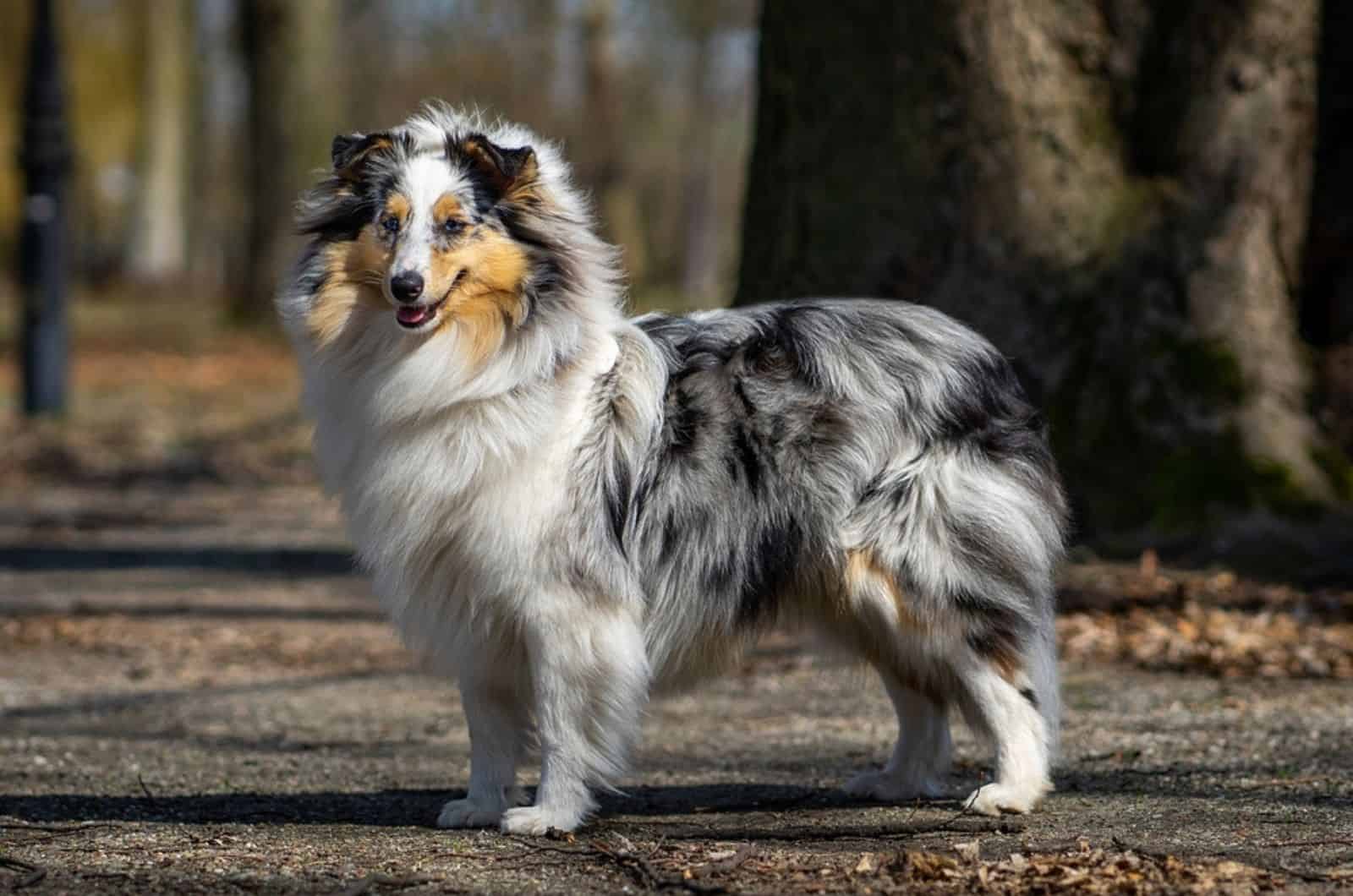
I am sure you are aware of the merle gene because the topic has been gaining traction in the last decade. For now, we will just say that this allele (a variant of a gene) is responsible for some incredible randomized patterns on the coat.
The blue base coat happens due to a dilution of the black pigment (eumelanin), while the merle gene creates splashes of less diluted or undiluted eumelanin over the base coat color. Keep in mind that a “blue” dog coat is a shade of lighter gray color, not quite blue.
Essentially, you get some random spots and blotches of black or darker dilute on a blue merle Shetland Sheepdog. Impactful as it is, the merle pattern is among the most sought-after in other dog breeds, too.
Let us not forget that a blue merle Sheltie is not a true Shetland sheepdog without a good portion of white color on the muzzle, tail tip, legs, chest, and neck. White spotting is present across many breeds, like the Cavalier King Charles Spaniel and its many color options.
Usually, I have to be the bearer of bad news in saying that a blue merle, or any of those variants individually, is not recognized by the American Kennel Club. Well, today is not that day.
It is one of the most well-established Sheltie looks, which means your choice of color is part of the breed-standard colors. It is by no means rare within the breed because it is an AKC-recognized classic, but it looks hypnotic nonetheless.
The genetic process behind this impressive artistic expression is not a simple one. Many things happen behind the scenes, resulting in a coat that looks incidental to us. However, this is not accidental, and here is why.
Sheltie Puppy Color Depends On The Pairing Of Its Parents’ Genes
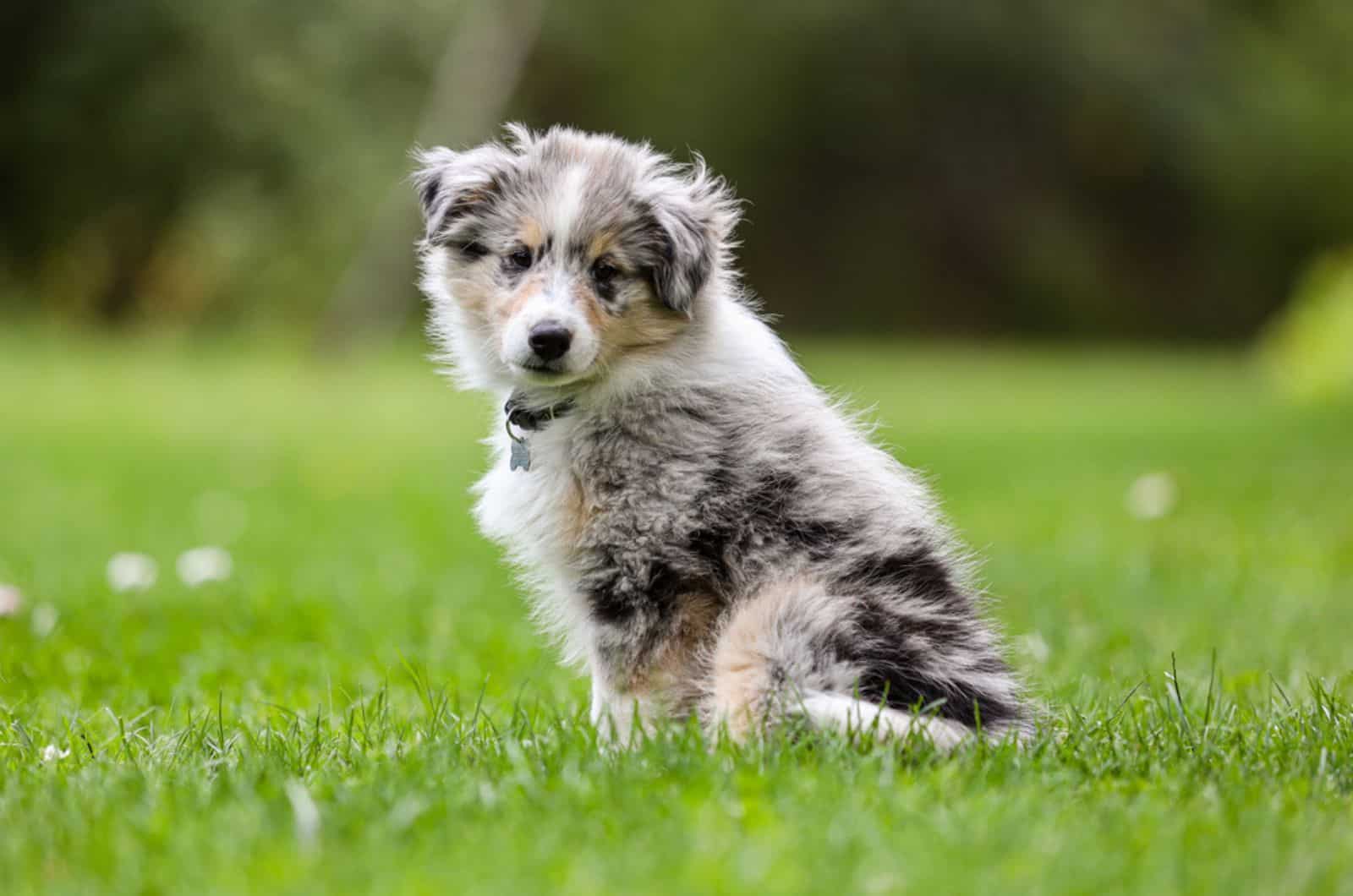
Two pigments, eumelanin (black) and phaeomelanin (red), determine every aspect of a dog’s coat color and even influence the phenotype (expression of genetic characteristics) in the eyes, muzzle, and paw pads.
Each of the parents, the dam and sire, pass on one pigment gene across the loci (locations on a gene) in the puppy’s DNA sequence. Which two are found on a particular locus defines the colors and patterns the coat will have.
A dog’s base coat color genetic journey always begins with the E locus. Also known as the extension locus, it controls the possibility of your dog’s coat being any color other than yellow. A melanistic mask (black muzzle) is created on a sub-locus of the E locus named Eᵐ.
If a pair of dominant genes, Eᵐ/Eᵐ or E/E, are found on the E locus, then your Sheltie’s MC1R protein will give the green light for black pigment production. Two Eᵐ only mean that there will be a black melanistic mask, otherwise, it does the same as the dominant E allele.
Next Loci In The Decision-Making Process
After the production of black pigment has been confirmed by two dominant genes on the E locus, the K locus (dominant black) will take over the infusion of eumelanin into the sequence. However, loci A, B, and D interact with the K locus, so the result will be influenced by their mingling.
Two dominant genes (Kᴮ/Kᴮ) on the K locus will signal the continuation of black pigment production. A pair of recessive genes like kʸ/kʸ would inhibit eumelanin production and cause a fawn, brindle, or sable coat pattern.
Since a blue merle Shetland sheepdog is blue, the pairing on the K locus has to be Kᴮ/Kᴮ. Next, the B locus pair of alleles will determine if the eumelanin will be diluted to a brown color or stay black.
Two dominant genes (B/B) or a dominant and recessive (B/b) will express a black phenotype, whereas two recessive ones (b/b) would dilute the color to brown. For a blue color, the pairing on the B locus has to be B/B or B/b.
Now we come to the interaction of the B locus with the D locus. Perhaps one of the most “popular” loci, the dilute gene is essentially a recessive gene on the D locus. As with every locus prior to it, a pair of recessive genes will cause a mutation.
In the case of a blue merle Sheltie, that mutation will be a dilute phenotype (blue or gray) due to the pairing of recessive genes. Up until recently, it was believed all dogs had either a d¹/d¹ or d²/d² allele pair that caused the dilution.
However, the new DNA findings from gene studies revealed that there is a third dilution variant, the d³. Interestingly enough, the d³ dilution is specific to the Shetland Sheepdog and a few other dog breeds like wolf-dog hybrids, Italian Greyhound, etc.
Adding The Merle Gene Causes The Blue Merle Dog Phenotype
Among the many colors of the Sheltie, blue merles are one-of-a-kind because there are several mutations that make its coat look the way it does.
Merle genes are located on the M locus, which is the only designated place an M locus can be found. Merle Shetland Collies are true representatives of their phenotype, with plenty of “design elements” displayed on their coats.
Its full name is the merle insertion variant of the PMEL gene. Unlike the dilution gene or “d” allele, this is a dominant recessive gene. The scope of the merle gene is confined, which means it only affects the distribution of eumelanin.
Since there are many random patterns produced by merle alleles, there has to be a parameter within themselves that influences the diversity of patterns. Indeed there is, and it has to do with the size of the M insertion variant.
Numbers assigned to the size have ranges that can predict the type of merle pattern to some degree. Here is a small table showing the number and pattern phenotype correlation.
[table id=692 /]
A harlequin merle pattern, in most cases, carries the most chance of substantial amounts of white coloring on the dog’s coat but is not the sole reason for the presence of white (or absence of color).
Double Merle Insertion Variants Are Dangerous For The Blue Merle Sheltie Dog
Molecular genetics is still not equipped to precisely determine the outcome of insertion mutations due to the unpredictability of the M allele. Size ranges can provide an estimate, but the difference in a single change in value can make the pattern completely different.
This arbitrariness is best shown in mosaicism. When M insertion variants replicate, every single cell can have a different degree of mutation, hence the name mosaicism. Random parameters are mostly not good news when it comes to genetics.
Because mosaicism affects the melanocytes (melanin cells), mutations with different values will cause the melanocytes to not form properly or deteriorate. These cells are present in the eye and hairs inside and outside the body, so eye and ear issues can occur.
Two dogs that express the merle phenotype, especially if the allele size is between 265 and 269, should never be bred. A pairing of m/m on the M locus means no merle phenotype, but any combination of M/m, M/M, or mᵐᵒˢ/M (mosaicism) will display a merle pattern.
As a recessive dominant gene, the merle gene will be passed on to the entire litter with the possibility of phenotype expression. Testing for merle insertion before breeding puppies from that litter is crucial in preventing the previously mentioned health problems.
Shelties with blue eyes are often found in double merles, but the eye color can have a different origin, as DNA testing suggested in a study performed by Embarkvet. A gene found on the eighteenth chromosome called ALX4 could be the reason behind blue eyes, too.
Final Touches Of White By The S Locus
White color is one of the defining features of the blue merle Shetland Sheepdog and its relative, the Border Collie. Not only that, but many color and pattern combinations of these two dog breeds include quite a big area of white coverage.
The S locus is the place where pigment (eumelanin in this case) production is inhibited or completely stopped. The flash, pied, piebald, and parti-colored patterns are all created in this location.
Mutations that take place on the S locus are, unfortunately, behind some vision and hearing problems due to their inhibition or halting of black pigment production.
The white pattern seen in Shelties and Border Collies is known as Irish spotting, but research is still fresh on the exact way the genes on this locus interact with other loci to express this phenotype.
Irish spotting presents itself on several parts of the body, including the muzzle, tip of the tail, legs, chest, and neck. For this to occur, there has to be at least one incompletely dominant S allele. So, an N/S or S/S genotype will potentially result in a white phenotype.
A special Sᶦ allele is considered the “maker” of the Irish spotting pattern, but things are slightly more complicated than a single allele making all the difference. For Collies (both Shetland and Border), the piebald gene (S) will express a more extreme white if there are more instances of it.
Since a white coat is the absence of pigment, an S/S means that two piebald alleles will have a higher chance of having a larger area of the coat covered in white. Dogs with a single piebald allele (N/S) can have no white coverage or up to fifty percent.
Meet The Sheepdog Behind The Blue Merle Sheltie Coat
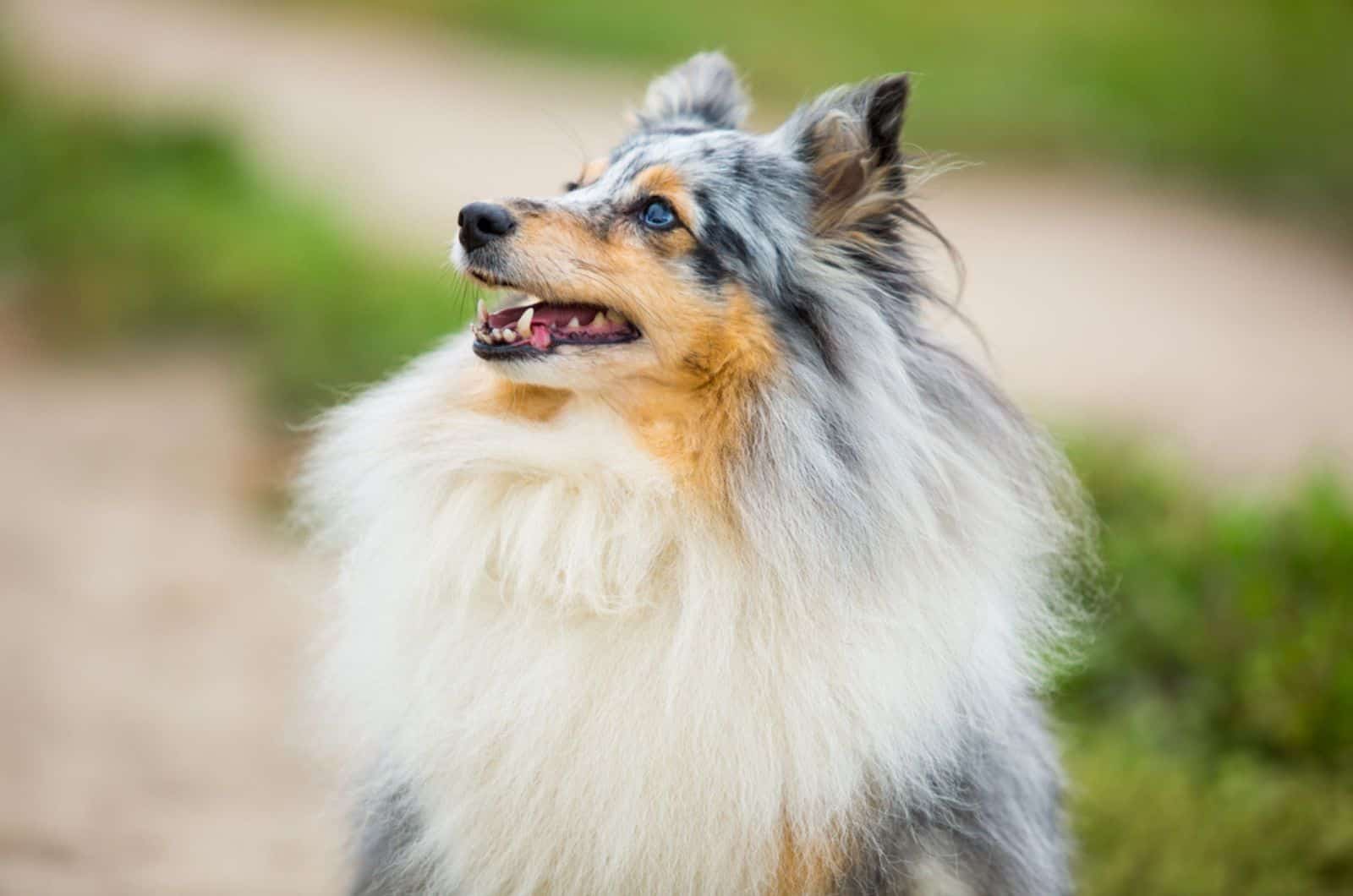
While humans often attribute coat colors to character, dogs react exclusively based on behavior. Despite being a blue merle Shetland Sheepdog, any Sheltie will be an amazing herding dog.
Their Shetland Islands origin makes them a Scotland native breed, despite being called an Australian Shepherd. Their shared ancestry with the rough Collie is apparent, but due to frequently being mistaken one for the other, Scotsmen wanted to clearly separate the two breeds.
The differences between the two breeds are not only in name, though. The Sheltie is much smaller at thirteen to sixteen inches in height and fifteen to twenty-five pounds in weight.
Most of the body proportions follow the Border Collie’s, but the frame is slightly stockier. The back is well-developed but shorter than its cousin’s. Strong feathering on the legs and neck is present in both dogs, which is a testament to the two breed’s strong common roots.
The coat length of the Sheltie dog is long, with a double coat. On the other hand, the Border Collie has a wavy medium-length coat over the undercoat. The number of available color combinations in the Shetland Sheepdog is significantly lower than in the Border Collie.
Shelties have fourteen color options that include black and white, tricolor, sable merle, sable, and more common ones. A bi-blue or bi-black combination is much rarer, the latter being considerably less frequent.
Border Collies are richer in terms of coat color (over twenty possibilities), with the addition of eight possible markings. In contrast, Shetland Sheepdogs have no markings according to the American Shetland Sheepdog Association and AKC’s breed standards.
Blue Merle Shetland Sheepdog Temperament
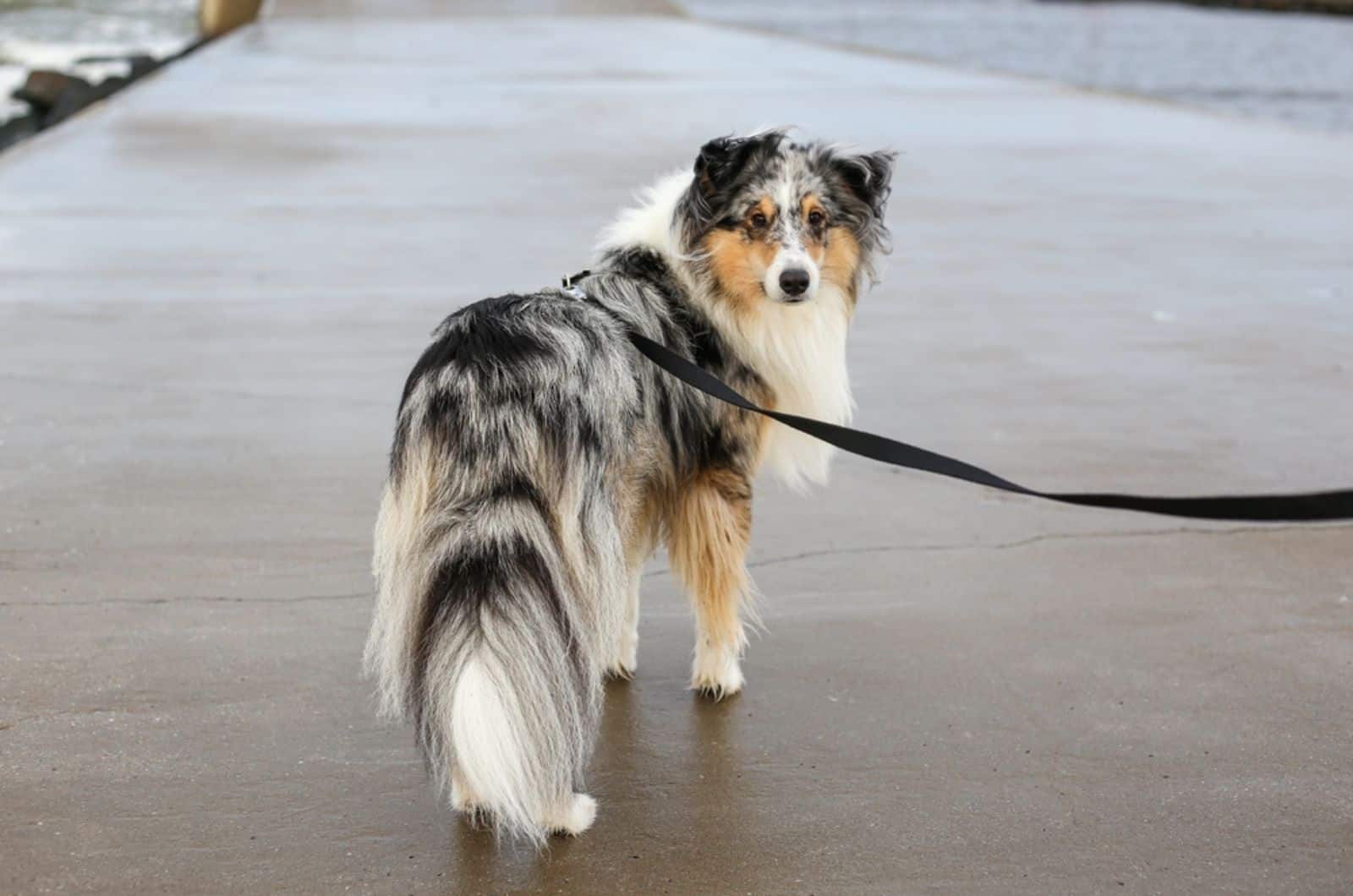
A blue merle Shetland Sheepdog puppy is cute. Its role as an adult, however, is very important and highly valued among many farmers and dog lovers. Purebred Shelties are small dogs with high drive.
Though exceptional family dogs, the breed is most known for its herding prowess. The athleticism of a Shetland Collie expands beyond micromanaging cattle. Their impressive agility, unrivaled responsiveness to dog training, and beautiful looks open numerous career paths.
Dog shows go perfectly well with their calm temperament and obedient nature. If you are looking for a best friend, this breed will raise the standards to a new level. Shelties are incredible with young children and other dogs and would give everything for their families.
A house with a large yard or a farm would be the perfect place for this dog breed, but apartment life with structured, intense physical activity outdoors is a close second. The Sheltie is not a good couch potato dog.
Have toys and stuff around yourself at any time of the day because its puppy-like playfulness never goes off. When stuff gets serious, the Shetland Sheepdog will be an excellent watchdog. Their protective instincts are on par with much fiercer breeds specializing in that role.
High trainability means that you can teach it to do virtually anything. The wits are something that the Sheltie carries deep in its genetics. A smart dog with high protective instincts will bark a lot. If you plan on having one in an apartment, you might want to get used to noise complaints.
Leaving a Sheltie alone for long periods of time can mean your interior will be turned from feng-shui into fang-chewy, so read this list of interactive toys for the times your Shetland Sheepdog will spend alone.
Health Problems In Blue Merle Shetland Sheepdog
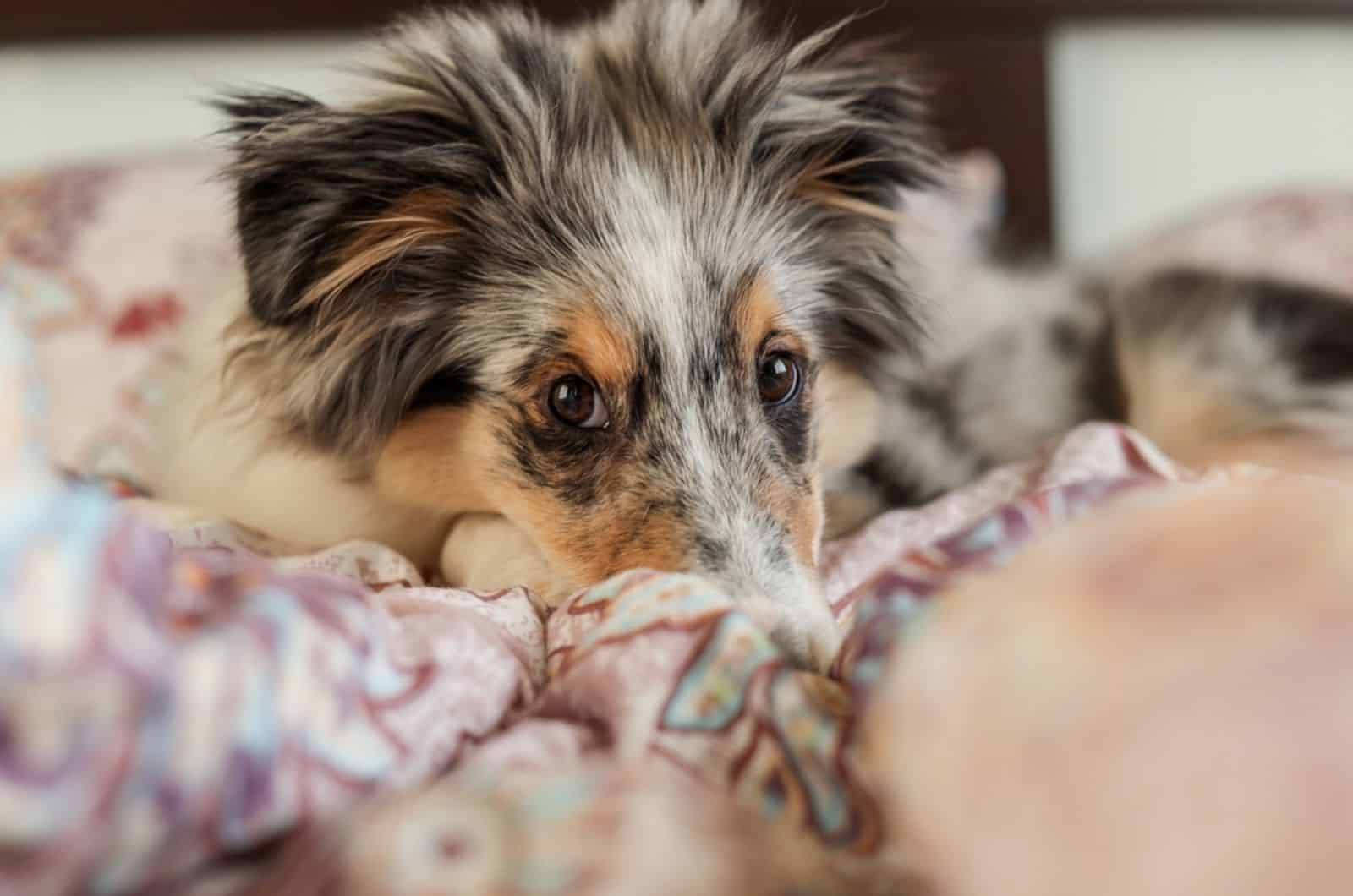
The genetics of a blue merle Sheltie can be a cause for concern. Double merle breeding is very popular with backyard breeders and puppy mills. Producing a dog that has an “exotic” color is often profit-driven, so making sure you are buying from a reputable breeder is a must.
Although a purebred dog is classified as one adhering to all breed standard parameters, these double merles or Shelties with genetic diseases that affect vital organs or have a progressive nature are most commonly visually identical to healthy dogs.
Other than vision and hearing problems, the blue merle Shetland Sheepdog and its differently colored brethren are susceptible to some other conditions. In the following chapters, we will quickly go through them.
Collie Eye Anomaly (CEA)
We only mentioned this eye condition in passing, but now I will explain what genetics from a double merle can cause in a Sheltie or Border Collie. The only known fact is that a mutated gene that affects cell development in the eye impacts vision.
Improperly formed eyes can extend the list of problems that stem from it, so a detached retina is a condition that can develop as a secondary issue. Eyeballs that are too small or too deeply set in the eye sockets are often put in connection with CEA.
Most vision problems become apparent only with the onset of complete blindness. Even if the loss of vision is partial, there is no way to undo the damage to the eye, so supportive care and lifestyle changes are the only treatment available.
Hypothyroidism
The definition of hypothyroidism is a thyroid gland that does not produce enough thyroxine and triiodothyronine. This directly affects key bodily functions like metabolism, body temperature control, nutrient absorption, etc.
It can have two different causes — idiopathic thyroid gland atrophy or lymphocytic thyroiditis. The latter is by far the most common cause, accounting for ninety-five percent of cases of hypothyroidism in dogs.
White blood cells (leucocytes) misinterpret the cells of the thyroid as a foreign body that needs to be destroyed, causing tissue damage and loss of gland function. The most common symptoms are lethargy, weight gain, degrading coat, slow heart rate, etc.
Treatment is lifelong and consists of hormone replacement therapy. A decent quality of life is expected for most dogs that are diagnosed early.
Patellar Luxation
Smaller dogs are more prone to a luxating patella. Being a miniature version of the Border Collie, the Sheltie dog is in the high-risk group. Since it is congenital, abnormal anatomy is already present in puppies.
In simple terms, this is a kneecap dislocation. What makes it a serious condition is that it keeps happening whenever your dog bends the knee. The cause is a loose tendon that detaches from the patella.
Symptoms are shared with similar conditions like hip dysplasia and include an irregular gait, step skipping, bowed legs, or leg shaking. Most treatment solutions include surgery since it is a structural problem.
Von Willebrand’s Disease
This hereditary disease reduces the clotting ability of the body. Von Willebrand’s factor (vWF) is a protein that facilitates thrombocyte adhesion to injured tissue. In Shelties, this blood disorder causes a low production of vWF that can be fatal even with minor injuries.
The inability to stop bleeding is very serious, and dogs with vWD are at risk of dying from the simplest procedure, like spaying or neutering. Having a mutation-rich genetic build, blue merle Shetland Sheepdogs are very susceptible to von Willebrand’s.
Until an injury or surgery, the dog will most likely be asymptomatic. However, some dogs can display symptoms like bleeding gums, blood from the vagina, or blood in feces and urine.
Treatment can include a variety of things, but blood transfusions and desmopressin (artificial hormone) proved to be the most effective in managing the condition.
Blue Merle Shetland Sheepdog FAQ
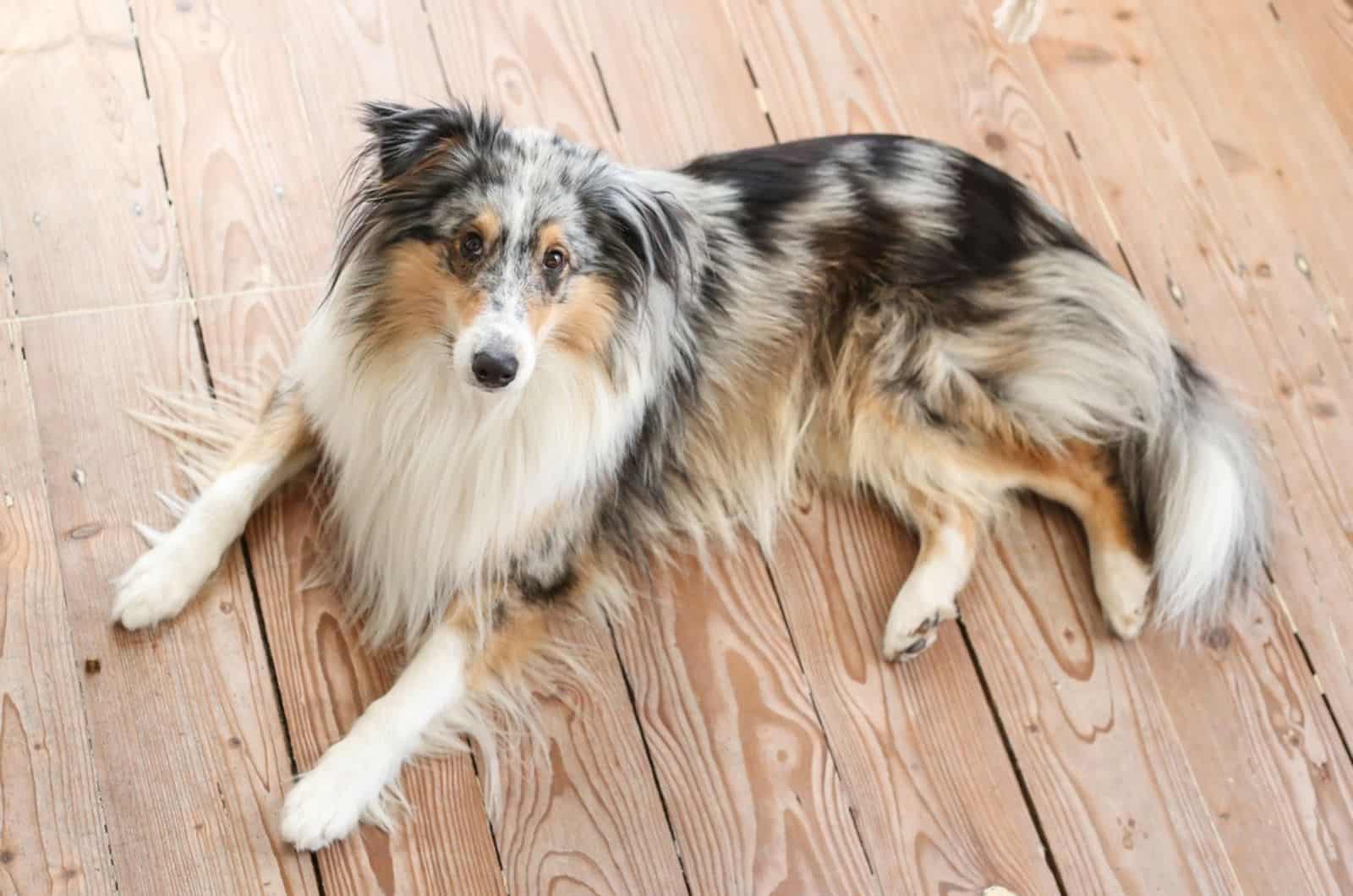
Answering this question is tough because there are many breeders that sell blue merle Shetland Sheepdogs. If you want one after reading about the possible health issue due to genetic mutations, you should stay with reputable breeders.
The cost of producing a blue merle Sheltie is high, so the price will be anywhere between $2500 and $5000. You might find breeders that sell for cheaper, but always be wary of scams.
Spending tens of thousands of dollars on medical bills throughout the dog’s life is not going to be worth the one or two thousand dollars lower acquisition price.
The pros are definitely that you get an intelligent, active, and family-loving dog. If you have a farm or ranch with cattle, you will appreciate this breed even more. Protective instincts in a Sheltie are high, and living with other dogs or animals presents no problem.
Going against it is mostly that it requires constant mental stimulation. If there is nothing to do, destructive behavior is common in Shetland Sheepdogs. Another thing that might deter you from getting one is their grooming and shedding potential.
A longer coat on a moderately shedding dog means seasonal coat changes will fill your house with hair. Regular grooming is also a must. A couple of hours every day will be ideal, but once or twice will not be enough. This is particularly important for people with allergies.
These cons are mostly relevant if you want to minimize your level of obligation when it comes to owning a dog. Otherwise, you will not even consider these as cons unless you are allergic to dog hair.
A blue Sheltie will not have the merle pattern (randomized spots of black or a darker dilution of it), whereas a blue merle will. On a genetic level, the difference can be the presence or absence of the merle gene altogether.
Even if a blue Sheltie does not express the merle phenotype, it does not mean the dog is not a carrier. Dogs with one merle allele (Cryptic merle) can express no pattern at all or show subtle color changes or a slightly visible pattern.
In most cases, the difference is most apparent in the lack of a merle pattern. However, DNA tests are very useful for both owners and breeders who wish to practice safe breeding or simply be aware of their dog’s genetic makeup.
Conclusion
The blue merle Sheltie looks splendid and has a great temperament for any type of lifestyle. Though it might be a difficult dog for first-time owners, it is nowhere near the worst choice.
Always consider the health problem implications that a blue merle Shetland Sheepdog carries with it. Never compromise on breeder quality for a couple of thousand dollars. Pay more now, and be safe later. Well, “much safer” is a better choice of words (nothing is guaranteed).
We have a great list of Shetland Sheepdog breeders that you should check out before Googling them.
An alternative for breeders that are considered good other than our list is the AKC Marketplace. The American Kennel Club has to inspect and approve all the breeders on their selling platform, so you, as a buyer, will be safer over there.
Read Next: Mini Shetland Sheepdog: Small, Yet A Great Herding Dog
